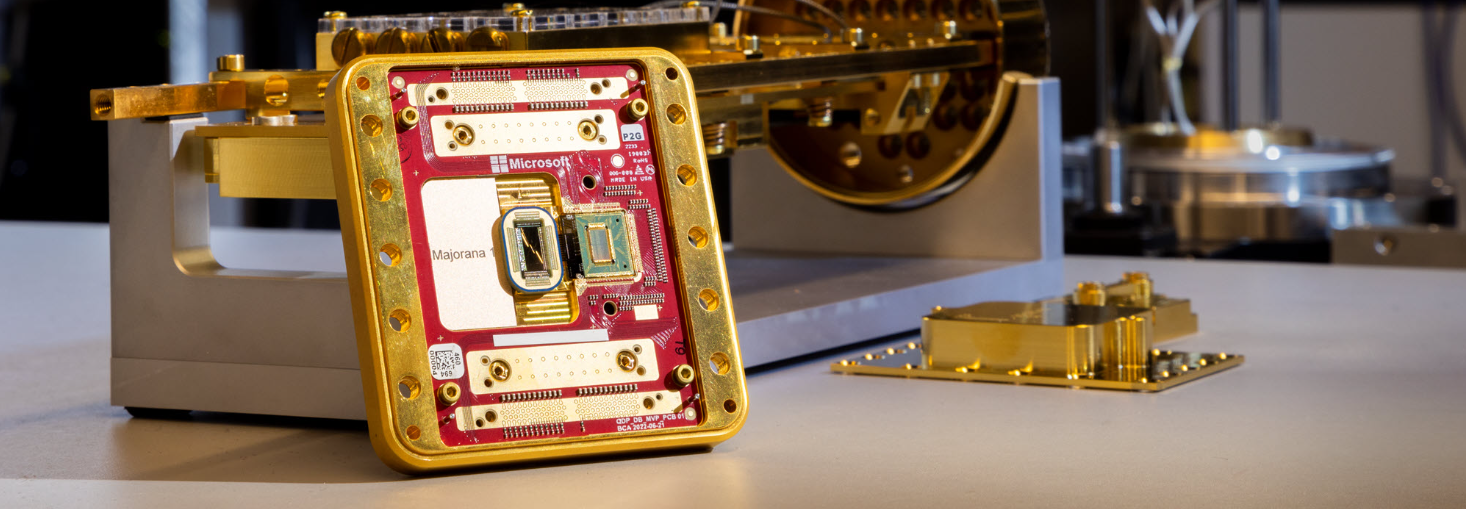Your cart is currently empty!

Topological Superconductors, Microsoft’s New State of Matter: A Breakthrough of 2025 in Quantum Computing
In the ever-evolving world of quantum computing, Microsoft has once again positioned itself at the forefront of innovation. The tech giant recently announced a groundbreaking discovery: a new state of matter that could revolutionize the field of quantum computing. This discovery is not just a scientific curiosity; it has the potential to unlock unprecedented computational power, bringing…
In the ever-evolving world of quantum computing, Microsoft has once again positioned itself at the forefront of innovation. The tech giant recently announced a groundbreaking discovery: a new state of matter that could revolutionize the field of quantum computing. This discovery is not just a scientific curiosity; it has the potential to unlock unprecedented computational power, bringing us closer to solving some of the world’s most complex problems. At the heart of this breakthrough lies the concept of a topological superconductor, a material that could pave the way for stable and scalable quantum computers. In this article, we will explore the significance of Microsoft’s new state of matter, its implications for quantum computing, and the role of topological superconductors in this exciting development.
Table of Contents
What is Microsoft’s New State of Matter?
Microsoft’s new state of matter is a scientific achievement that bridges the gap between theoretical physics and practical engineering. While most people are familiar with the three classical states of matter—solid, liquid, and gas—there are actually many more exotic states that exist under specific conditions. Microsoft’s discovery falls into this category, representing a unique phase of matter that exhibits topological properties.
This new state of matter is closely tied to the field of quantum computing, where traditional binary systems (0s and 1s) are replaced by quantum bits or qubits. Unlike classical bits, qubits can exist in a superposition of states, enabling them to perform multiple calculations simultaneously. However, qubits are notoriously fragile and prone to errors caused by environmental interference. Microsoft’s new state of matter addresses this challenge by providing a more stable foundation for qubits, potentially making quantum computers more reliable and scalable.
The Role of Topological Superconductors
At the core of Microsoft’s discovery is the concept of a topological superconductor. To understand why this is such a big deal, let’s break it down:
What is a Topological Superconductor?
A topological superconductor is a material that exhibits superconductivity—a state in which electrical resistance vanishes—while also displaying topological properties. These properties are related to the material’s geometric structure and its ability to conduct electricity on its surface without losing energy. The most intriguing aspect of topological superconductors is their ability to host Majorana fermions, exotic particles that could serve as the building blocks for stable qubits.
Why Are Topological Superconductors Important for Quantum Computing?
Quantum computers rely on qubits to perform calculations, but these qubits are highly sensitive to external disturbances, a phenomenon known as decoherence. Topological superconductors offer a solution to this problem by providing a more robust environment for qubits. Majorana fermions, which emerge in these materials, are inherently resistant to decoherence, making them ideal candidates for quantum computing.
Microsoft’s research into topological superconductors has led to the creation of a new state of matter that supports these exotic particles. This breakthrough could significantly reduce the error rates in quantum computations, bringing us closer to achieving fault-tolerant quantum computing.
The Science Behind the Discovery
Microsoft’s new state of matter is the result of years of research in condensed matter physics and quantum mechanics. Here’s a closer look at the science behind this groundbreaking discovery:
1. Topological Quantum Computing
Topological quantum computing is a paradigm that leverages the properties of topological states of matter to create more stable qubits. Unlike traditional qubits, which are vulnerable to environmental noise, topological qubits are protected by their geometric structure. This makes them less prone to errors and more suitable for large-scale quantum computations.
2. Majorana Fermions
Majorana fermions are particles that act as their own antiparticles, a property that makes them uniquely suited for quantum computing. These particles were first predicted by Italian physicist Ettore Majorana in 1937, but it wasn’t until recently that scientists were able to observe them in topological superconductors. Microsoft’s discovery of a new state of matter that supports Majorana fermions is a significant step forward in the quest for practical quantum computers.
Related Article: Microsoft Majorana 1 Chip: The Future of Scalable Quantum Computing in 2025
3. Material Science Innovations
Creating a topological superconductor requires precise control over the material’s properties. Microsoft’s team used advanced techniques in material science to engineer a new state of matter that exhibits the desired topological and superconducting properties. This involved manipulating the material’s atomic structure and ensuring that it could maintain its stability under extreme conditions.
Implications for Quantum Computing
Microsoft’s new state of matter has far-reaching implications for the future of quantum computing. Here are some of the key benefits:
1. Error Reduction
One of the biggest challenges in quantum computing is managing errors caused by decoherence. Topological qubits, which are supported by Microsoft’s new state of matter, are inherently more stable than traditional qubits. This could lead to a significant reduction in error rates, making quantum computers more reliable and practical.
2. Scalability
Scalability is another major hurdle in quantum computing. Current quantum systems are limited in size due to the difficulty of maintaining coherence across multiple qubits. Microsoft’s discovery could enable the creation of larger, more complex quantum systems, paving the way for breakthroughs in fields like cryptography, materials science, and artificial intelligence.
3. Fault-Tolerant Quantum Computing
Fault-tolerant quantum computing is the holy grail of the field. By leveraging the properties of topological superconductors, Microsoft’s new state of matter brings us closer to achieving this goal. Fault-tolerant quantum computers would be capable of performing calculations that are currently impossible, opening up new possibilities for scientific discovery and technological innovation.
Beyond Quantum Computing: Other Applications
While the primary focus of Microsoft’s new state of matter is quantum computing, its implications extend far beyond this field. Here are some potential applications:
1. Energy Efficiency
Topological superconductors have the potential to revolutionize energy transmission and storage. By enabling electricity to flow without resistance, these materials could significantly reduce energy losses, leading to more efficient power grids and sustainable energy solutions.
2. Advanced Materials
The discovery of new states of matter could lead to the development of advanced materials with unique properties. These materials could be used in a wide range of applications, from electronics to aerospace engineering.
3. Medical Imaging
Quantum technologies have the potential to transform medical imaging, enabling more accurate and detailed scans. Microsoft’s new state of matter could play a key role in the development of next-generation imaging devices.
Challenges and Future Directions
Despite its promise, Microsoft’s new state of matter is not without challenges. Here are some of the obstacles that need to be overcome:
1. Material Synthesis
Creating topological superconductors with the desired properties is a complex and resource-intensive process. Researchers will need to develop more efficient methods for synthesizing these materials.
2. Temperature Constraints
Most topological superconductors require extremely low temperatures to function. Finding ways to achieve these conditions at a practical scale will be crucial for real-world applications.
3. Integration with Existing Technologies
Integrating topological qubits with existing quantum computing architectures is another challenge. Researchers will need to develop new protocols and interfaces to ensure compatibility.
Looking ahead, Microsoft’s discovery opens up exciting new avenues for research and development. As scientists continue to explore the properties of this new state of matter, we can expect to see further breakthroughs in quantum computing and beyond.
Conclusion
Microsoft’s new state of matter represents a monumental leap forward in the fields of quantum computing and material science. By harnessing the power of topological superconductors, this discovery has the potential to overcome some of the biggest challenges in quantum computing, from error reduction to scalability. Beyond quantum computing, the implications of this breakthrough extend to energy efficiency, advanced materials, and medical imaging, among other fields.
While there are still challenges to be addressed, the future looks bright for Microsoft’s new state of matter. As researchers continue to push the boundaries of what’s possible, we can expect to see even more exciting developments in the years to come. This discovery is not just a testament to Microsoft’s commitment to innovation; it’s a reminder of the transformative power of science and technology.
In a world where the pace of technological advancement shows no signs of slowing down, Microsoft’s new state of the matter stands as a beacon of progress, offering a glimpse into a future where the impossible becomes possible. Whether it’s solving complex problems, revolutionizing industries, or unlocking new frontiers of knowledge, the potential of this discovery is truly limitless.
FAQs
What is Microsoft’s new state of matter?
Microsoft’s new state of matter is a unique phase of matter that exhibits topological properties, making it highly stable and resistant to external disturbances. This discovery is particularly significant for quantum computing, as it provides a more robust foundation for qubits, the building blocks of quantum computers.
How does this new state of matter relate to quantum computing?
The new state of matter supports topological qubits, which are more stable and less prone to errors than traditional qubits. This could significantly reduce error rates in quantum computations, making quantum computers more reliable and scalable. It brings us closer to achieving fault-tolerant quantum computing, a major milestone in the field.
What are topological superconductors?
Topological superconductors are materials that combine superconductivity (zero electrical resistance) with topological properties (geometric structures that enable unique surface behaviors). These materials can host Majorana fermions, exotic particles that are key to creating stable qubits for quantum computing.
What are Majorana fermions, and why are they important?
Majorana fermions are particles that act as their own antiparticles, a property predicted by physicist Ettore Majorana in 1937. They are important because they are highly resistant to environmental noise, making them ideal for creating stable qubits in quantum computers. Microsoft’s new state of matter supports the existence of these particles.
How does this discovery improve quantum computing?
This discovery improves quantum computing by:
Reducing errors: Topological qubits are less prone to decoherence, a major source of errors in quantum systems.
Enhancing scalability: The stability of topological qubits could enable the creation of larger, more complex quantum systems.
Advancing fault tolerance: The discovery brings us closer to building quantum computers that can operate reliably without constant error correction.
What are the potential applications beyond quantum computing?
Beyond quantum computing, Microsoft’s new state of matter and topological superconductors could have applications in:
Energy efficiency: Enabling lossless energy transmission and storage.
Advanced materials: Developing new materials with unique properties for electronics, aerospace, and more.
Medical imaging: Improving the accuracy and detail of medical scans through quantum technologies.
What challenges remain in realizing this technology?
Key challenges include:
Material synthesis: Creating topological superconductors with the desired properties is complex and resource-intensive.
Temperature constraints: Most topological superconductors require extremely low temperatures to function.
Integration: Combining topological qubits with existing quantum computing architectures requires new protocols and interfaces.
How does this discovery impact the tech industry?
This discovery could revolutionize the tech industry by:
Accelerating the development of practical quantum computers.
Enabling breakthroughs in fields like cryptography, materials science, and artificial intelligence.
Driving innovation in energy efficiency and advanced materials.
What role does Microsoft play in quantum computing research?
Microsoft is a leader in quantum computing research, particularly in the area of topological quantum computing. Through its Station Q research lab and partnerships with academic institutions, Microsoft is advancing the development of stable qubits and scalable quantum systems.
What do Topological Superconductors mean for the future of computing?
Microsoft’s new state of matter represents a paradigm shift in computing. By enabling stable and scalable quantum systems, this discovery could unlock unprecedented computational power, transforming industries and solving problems that are currently beyond our reach. It marks a significant step toward a future where quantum computing is an integral part of our technological landscape.


